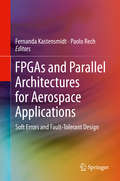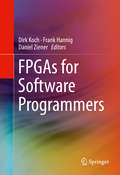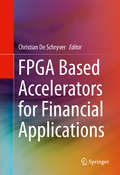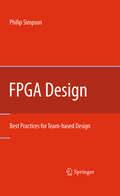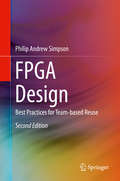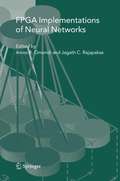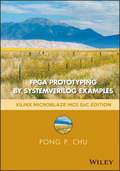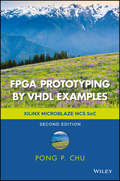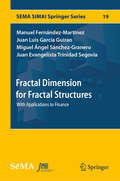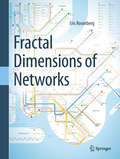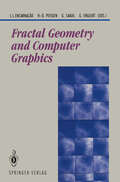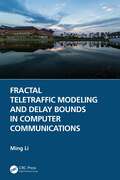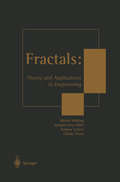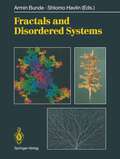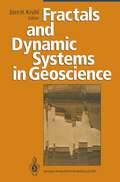- Table View
- List View
FPGAs and Parallel Architectures for Aerospace Applications: Soft Errors and Fault-Tolerant Design
by Fernanda Kastensmidt Paolo RechThis book introduces the concepts of soft errors in FPGAs, as well as the motivation for using commercial, off-the-shelf (COTS) FPGAs in mission-critical and remote applications, such as aerospace. The authors describe the effects of radiation in FPGAs, present a large set of soft-error mitigation techniques that can be applied in these circuits, as well as methods for qualifying these circuits under radiation. Coverage includes radiation effects in FPGAs, fault-tolerant techniques for FPGAs, use of COTS FPGAs in aerospace applications, experimental data of FPGAs under radiation, FPGA embedded processors under radiation and fault injection in FPGAs. Since dedicated parallel processing architectures such as GPUs have become more desirable in aerospace applications due to high computational power, GPU analysis under radiation is also discussed.
FPGAs for Software Programmers
by Dirk Koch Frank Hannig Daniel ZienerThis book makes powerful Field Programmable Gate Array (FPGA) and reconfigurable technology accessible to software engineers by covering different state-of-the-art high-level synthesis approaches (e.g., OpenCL and several C-to-gates compilers). It introduces FPGA technology, its programming model, and how various applications can be implemented on FPGAs without going through low-level hardware design phases. Readers will get a realistic sense for problems that are suited for FPGAs and how to implement them from a software designer’s point of view. The authors demonstrate that FPGAs and their programming model reflect the needs of stream processing problems much better than traditional CPU or GPU architectures, making them well-suited for a wide variety of systems, from embedded systems performing sensor processing to large setups for Big Data number crunching. This book serves as an invaluable tool for software designers and FPGA design engineers who are interested in high design productivity through behavioural synthesis, domain-specific compilation, and FPGA overlays.Introduces FPGA technology to software developers by giving an overview of FPGA programming models and design tools, as well as various application examples;Provides a holistic analysis of the topic and enables developers to tackle the architectural needs for Big Data processing with FPGAs;Explains the reasons for the energy efficiency and performance benefits of FPGA processing;Provides a user-oriented approach and a sense for where and how to apply FPGA technology.
FPGA Based Accelerators for Financial Applications
by Christian SchryverThis book covers the latest approaches and results from reconfigurable computing architectures employed in the finance domain. So-called field-programmable gate arrays (FPGAs) have already shown to outperform standard CPU- and GPU-based computing architectures by far, saving up to 99% of energy depending on the compute tasks. Renowned authors from financial mathematics, computer architecture and finance business introduce the readers into today’s challenges in finance IT, illustrate the most advanced approaches and use cases and present currently known methodologies for integrating FPGAs in finance systems together with latest results. The complete algorithm-to-hardware flow is covered holistically, so this book serves as a hands-on guide for IT managers, researchers and quants/programmers who think about integrating FPGAs into their current IT systems.
FPGA Design: Best Practices for Team-based Design
by Philip SimpsonIn August of 2006, an engineering VP from one of Altera’s customers approached Misha Burich, VP of Engineering at Altera, asking for help in reliably being able to predict the cost, schedule and quality of system designs reliant on FPGA designs. At this time, I was responsible for defining the design flow requirements for the Altera design software and was tasked with investigating this further. As I worked with the customer to understand what worked and what did not work reliably in their FPGA design process, I noted that this problem was not unique to this one customer. The characteristics of the problem are shared by many Corporations that implement designs in FPGAs. The Corporation has many design teams at different locations and the success of the FPGA projects vary between the teams. There is a wide range of design experience across the teams. There is no working process for sharing design blocks between engineering teams. As I analyzed the data that I had received from hundreds of customer visits in the past, I noticed that design reuse among engineering teams was a challenge. I also noticed that many of the design teams at the same Companies and even within the same design team used different design methodologies. Altera had recently solved this problem as part of its own FPGA design software and IP development process.
FPGA Design: Best Practices for Team-based Reuse
by Philip Andrew SimpsonThis book describes best practices for successful FPGA design. It is the result of the author’s meetings with hundreds of customers on the challenges facing each of their FPGA design teams. By gaining an understanding into their design environments, processes, what works and what does not work, key areas of concern in implementing system designs have been identified and a recommended design methodology to overcome these challenges has been developed.This book’s content has a strong focus on design teams that are spread across sites. The goal being to increase the productivity of FPGA design teams by establishing a common methodology across design teams; enabling the exchange of design blocks across teams.Coverage includes the complete FPGA design flow, from the basics to advanced techniques. This new edition has been enhanced to include new sections on System modeling, embedded design and high level design. The original sections on Design Environment, RTL design and timing closure have all been expanded to include more up to date techniques as well as providing more extensive scripts and RTL code that can be reused by readers.Presents complete, field-tested methodology for FPGA design, focused on reuse across design teams;Offers best practices for FPGA timing closure, in-system debug, and board design;Details techniques to resolve common pitfalls in designing with FPGAs.
FPGA EDA: Design Principles and Implementation
by Kaihui Tu Xifan Tang Cunxi Yu Lana Josipović Zhufei ChuThis book focuses on FPGA EDA tools, the very foundation of FPGA technology. Instead of illustrating how to use them, this book dives into the tools themselves, revealing how these tools are being designed and how they may improve. Unlike other semiconductors, FPGA has a distinctive two-stage EDA system: chip design EDA and application design EDA.State-of-the-art algorithms, data models and design methodologies/standards are the main concerns of this book, and these will be very helpful for FPGA EDA engineers and researchers to obtain a bird’s eye view of this complicated knowledge system. In the chip design EDA part, full-custom and semicustom methodologies bring up ASIC-like EDA tools, and in the application design EDA side, typical topics including high-level synthesis, logic synthesis, physical implementation, bitstream configuration, etc., are well discussed.
FPGA Implementations of Neural Networks
by Amos R. Omondi Jagath C. RajapakseDuring the 1980s and early 1990s there was signi?cant work in the design and implementation of hardware neurocomputers. Nevertheless, most of these efforts may be judged to have been unsuccessful: at no time have have ha- ware neurocomputers been in wide use. This lack of success may be largely attributed to the fact that earlier work was almost entirely aimed at developing custom neurocomputers, based on ASIC technology, but for such niche - eas this technology was never suf?ciently developed or competitive enough to justify large-scale adoption. On the other hand, gate-arrays of the period m- tioned were never large enough nor fast enough for serious arti?cial-neur- network (ANN) applications. But technology has now improved: the capacity and performance of current FPGAs are such that they present a much more realistic alternative. Consequently neurocomputers based on FPGAs are now a much more practical proposition than they have been in the past. This book summarizes some work towards this goal and consists of 12 papers that were selected, after review, from a number of submissions. The book is nominally divided into three parts: Chapters 1 through 4 deal with foundational issues; Chapters 5 through 11 deal with a variety of implementations; and Chapter 12 looks at the lessons learned from a large-scale project and also reconsiders design issues in light of current and future technology.
FPGA Prototyping by SystemVerilog Examples: Xilinx MicroBlaze MCS SoC Edition
by Pong P. ChuA hands-on introduction to FPGA prototyping and SoC design This is the successor edition of the popular FPGA Prototyping by Verilog Examples text. It follows the same “learning-by-doing” approach to teach the fundamentals and practices of HDL synthesis and FPGA prototyping. The new edition uses a coherent series of examples to demonstrate the process to develop sophisticated digital circuits and IP (intellectual property) cores, integrate them into an SoC (system on a chip) framework, realize the system on an FPGA prototyping board, and verify the hardware and software operation. The examples start with simple gate-level circuits, progress gradually through the RT (register transfer) level modules, and lead to a functional embedded system with custom I/O peripherals and hardware accelerators. Although it is an introductory text, the examples are developed in a rigorous manner, and the derivations follow the strict design guidelines and coding practices used for large, complex digital systems. The book is completely updated and uses the SystemVerilog language, which “absorbs” the Verilog language. It presents the hardware design in the SoC context and introduces the hardware-software co-design concept. Instead of treating examples as isolated entities, the book integrates them into a single coherent SoC platform that allows readers to explore both hardware and software “programmability” and develop complex and interesting embedded system projects. The new edition: Adds four general-purpose IP cores, which are multi-channel PWM (pulse width modulation) controller, I2C controller, SPI controller, and XADC (Xilinx analog-to-digital converter) controller. Introduces a music synthesizer constructed with a DDFS (direct digital frequency synthesis) module and an ADSR (attack-decay-sustain-release) envelope generator. Expands the original video controller into a complete stream based video subsystem that incorporates a video synchronization circuit, a test-pattern generator, an OSD (on-screen display) controller, a sprite generator, and a frame buffer. Provides a detailed discussion on blocking and nonblocking statements and coding styles. Describes basic concepts of software-hardware co-design with Xilinx MicroBlaze MCS soft-core processor. Provides an overview of bus interconnect and interface circuit. Presents basic embedded system software development. Suggests additional modules and peripherals for interesting and challenging projects. FPGA Prototyping by SystemVerilog Examples makes a natural companion text for introductory and advanced digital design courses and embedded system courses. It also serves as an ideal self-teaching guide for practicing engineers who wish to learn more about this emerging area of interest.
FPGA Prototyping by SystemVerilog Examples: Xilinx MicroBlaze MCS SoC Edition
by Pong P. ChuA hands-on introduction to FPGA prototyping and SoC design This is the successor edition of the popular FPGA Prototyping by Verilog Examples text. It follows the same “learning-by-doing” approach to teach the fundamentals and practices of HDL synthesis and FPGA prototyping. The new edition uses a coherent series of examples to demonstrate the process to develop sophisticated digital circuits and IP (intellectual property) cores, integrate them into an SoC (system on a chip) framework, realize the system on an FPGA prototyping board, and verify the hardware and software operation. The examples start with simple gate-level circuits, progress gradually through the RT (register transfer) level modules, and lead to a functional embedded system with custom I/O peripherals and hardware accelerators. Although it is an introductory text, the examples are developed in a rigorous manner, and the derivations follow the strict design guidelines and coding practices used for large, complex digital systems. The book is completely updated and uses the SystemVerilog language, which “absorbs” the Verilog language. It presents the hardware design in the SoC context and introduces the hardware-software co-design concept. Instead of treating examples as isolated entities, the book integrates them into a single coherent SoC platform that allows readers to explore both hardware and software “programmability” and develop complex and interesting embedded system projects. The new edition: Adds four general-purpose IP cores, which are multi-channel PWM (pulse width modulation) controller, I2C controller, SPI controller, and XADC (Xilinx analog-to-digital converter) controller. Introduces a music synthesizer constructed with a DDFS (direct digital frequency synthesis) module and an ADSR (attack-decay-sustain-release) envelope generator. Expands the original video controller into a complete stream based video subsystem that incorporates a video synchronization circuit, a test-pattern generator, an OSD (on-screen display) controller, a sprite generator, and a frame buffer. Provides a detailed discussion on blocking and nonblocking statements and coding styles. Describes basic concepts of software-hardware co-design with Xilinx MicroBlaze MCS soft-core processor. Provides an overview of bus interconnect and interface circuit. Presents basic embedded system software development. Suggests additional modules and peripherals for interesting and challenging projects. FPGA Prototyping by SystemVerilog Examples makes a natural companion text for introductory and advanced digital design courses and embedded system courses. It also serves as an ideal self-teaching guide for practicing engineers who wish to learn more about this emerging area of interest.
FPGA Prototyping by Verilog Examples: Xilinx Spartan-3 Version
by Pong P. ChuFPGA Prototyping Using Verilog Examples will provide you with a hands-on introduction to Verilog synthesis and FPGA programming through a “learn by doing” approach. By following the clear, easy-to-understand templates for code development and the numerous practical examples, you can quickly develop and simulate a sophisticated digital circuit, realize it on a prototyping device, and verify the operation of its physical implementation. This introductory text that will provide you with a solid foundation, instill confidence with rigorous examples for complex systems and prepare you for future development tasks.
FPGA Prototyping by Verilog Examples: Xilinx Spartan-3 Version
by Pong P. ChuFPGA Prototyping Using Verilog Examples will provide you with a hands-on introduction to Verilog synthesis and FPGA programming through a “learn by doing” approach. By following the clear, easy-to-understand templates for code development and the numerous practical examples, you can quickly develop and simulate a sophisticated digital circuit, realize it on a prototyping device, and verify the operation of its physical implementation. This introductory text that will provide you with a solid foundation, instill confidence with rigorous examples for complex systems and prepare you for future development tasks.
FPGA Prototyping by VHDL Examples: Xilinx MicroBlaze MCS SoC
by Pong P. ChuA hands-on introduction to FPGA prototyping and SoC design This Second Edition of the popular book follows the same “learning-by-doing” approach to teach the fundamentals and practices of VHDL synthesis and FPGA prototyping. It uses a coherent series of examples to demonstrate the process to develop sophisticated digital circuits and IP (intellectual property) cores, integrate them into an SoC (system on a chip) framework, realize the system on an FPGA prototyping board, and verify the hardware and software operation. The examples start with simple gate-level circuits, progress gradually through the RT (register transfer) level modules, and lead to a functional embedded system with custom I/O peripherals and hardware accelerators. Although it is an introductory text, the examples are developed in a rigorous manner, and the derivations follow strict design guidelines and coding practices used for large, complex digital systems. The new edition is completely updated. It presents the hardware design in the SoC context and introduces the hardware-software co-design concept. Instead of treating examples as isolated entities, the book integrates them into a single coherent SoC platform that allows readers to explore both hardware and software “programmability” and develop complex and interesting embedded system projects. The revised edition: Adds four general-purpose IP cores, which are multi-channel PWM (pulse width modulation) controller, I2C controller, SPI controller, and XADC (Xilinx analog-to-digital converter) controller. Introduces a music synthesizer constructed with a DDFS (direct digital frequency synthesis) module and an ADSR (attack-decay-sustain-release) envelop generator. Expands the original video controller into a complete stream-based video subsystem that incorporates a video synchronization circuit, a test pattern generator, an OSD (on-screen display) controller, a sprite generator, and a frame buffer. Introduces basic concepts of software-hardware co-design with Xilinx MicroBlaze MCS soft-core processor. Provides an overview of bus interconnect and interface circuit. Introduces basic embedded system software development. Suggests additional modules and peripherals for interesting and challenging projects. The FPGA Prototyping by VHDL Examples, Second Edition makes a natural companion text for introductory and advanced digital design courses and embedded system course. It also serves as an ideal self-teaching guide for practicing engineers who wish to learn more about this emerging area of interest.
FPGA Prototyping by VHDL Examples: Xilinx Spartan-3 Version
by Pong P. ChuThis book uses a "learn by doing" approach to introduce the concepts and techniques of VHDL and FPGA to designers through a series of hands-on experiments. FPGA Prototyping by VHDL Examples provides a collection of clear, easy-to-follow templates for quick code development; a large number of practical examples to illustrate and reinforce the concepts and design techniques; realistic projects that can be implemented and tested on a Xilinx prototyping board; and a thorough exploration of the Xilinx PicoBlaze soft-core microcontroller.
FPGA Prototyping by VHDL Examples: Xilinx MicroBlaze MCS SoC
by Pong P. ChuA hands-on introduction to FPGA prototyping and SoC design This Second Edition of the popular book follows the same “learning-by-doing” approach to teach the fundamentals and practices of VHDL synthesis and FPGA prototyping. It uses a coherent series of examples to demonstrate the process to develop sophisticated digital circuits and IP (intellectual property) cores, integrate them into an SoC (system on a chip) framework, realize the system on an FPGA prototyping board, and verify the hardware and software operation. The examples start with simple gate-level circuits, progress gradually through the RT (register transfer) level modules, and lead to a functional embedded system with custom I/O peripherals and hardware accelerators. Although it is an introductory text, the examples are developed in a rigorous manner, and the derivations follow strict design guidelines and coding practices used for large, complex digital systems. The new edition is completely updated. It presents the hardware design in the SoC context and introduces the hardware-software co-design concept. Instead of treating examples as isolated entities, the book integrates them into a single coherent SoC platform that allows readers to explore both hardware and software “programmability” and develop complex and interesting embedded system projects. The revised edition: Adds four general-purpose IP cores, which are multi-channel PWM (pulse width modulation) controller, I2C controller, SPI controller, and XADC (Xilinx analog-to-digital converter) controller. Introduces a music synthesizer constructed with a DDFS (direct digital frequency synthesis) module and an ADSR (attack-decay-sustain-release) envelop generator. Expands the original video controller into a complete stream-based video subsystem that incorporates a video synchronization circuit, a test pattern generator, an OSD (on-screen display) controller, a sprite generator, and a frame buffer. Introduces basic concepts of software-hardware co-design with Xilinx MicroBlaze MCS soft-core processor. Provides an overview of bus interconnect and interface circuit. Introduces basic embedded system software development. Suggests additional modules and peripherals for interesting and challenging projects. The FPGA Prototyping by VHDL Examples, Second Edition makes a natural companion text for introductory and advanced digital design courses and embedded system course. It also serves as an ideal self-teaching guide for practicing engineers who wish to learn more about this emerging area of interest.
FPGA Prototyping by VHDL Examples: Xilinx Spartan-3 Version
by Pong P. ChuThis book uses a "learn by doing" approach to introduce the concepts and techniques of VHDL and FPGA to designers through a series of hands-on experiments. FPGA Prototyping by VHDL Examples provides a collection of clear, easy-to-follow templates for quick code development; a large number of practical examples to illustrate and reinforce the concepts and design techniques; realistic projects that can be implemented and tested on a Xilinx prototyping board; and a thorough exploration of the Xilinx PicoBlaze soft-core microcontroller.
Fractal Dimension for Fractal Structures: With Applications to Finance (SEMA SIMAI Springer Series #19)
by Manuel Fernández-Martínez Juan Luis García Guirao Miguel Ángel Sánchez-Granero Juan Evangelista Trinidad SegoviaThis book provides a generalised approach to fractal dimension theory from the standpoint of asymmetric topology by employing the concept of a fractal structure. The fractal dimension is the main invariant of a fractal set, and provides useful information regarding the irregularities it presents when examined at a suitable level of detail. New theoretical models for calculating the fractal dimension of any subset with respect to a fractal structure are posed to generalise both the Hausdorff and box-counting dimensions. Some specific results for self-similar sets are also proved. Unlike classical fractal dimensions, these new models can be used with empirical applications of fractal dimension including non-Euclidean contexts. In addition, the book applies these fractal dimensions to explore long-memory in financial markets. In particular, novel results linking both fractal dimension and the Hurst exponent are provided. As such, the book provides a number of algorithms for properly calculating the self-similarity exponent of a wide range of processes, including (fractional) Brownian motion and Lévy stable processes. The algorithms also make it possible to analyse long-memory in real stocks and international indexes.This book is addressed to those researchers interested in fractal geometry, self-similarity patterns, and computational applications involving fractal dimension and Hurst exponent.
Fractal Dimensions of Networks (Springerbriefs In Computer Science Ser.)
by Eric RosenbergCurrent interest in fractal dimensions of networks is the result of more than a century of previous research on dimensions. Fractal Dimensions of Networks ties the theory and methods for computing fractal dimensions of networks to the “classic” theory of dimensions of geometric objects.The goal of the book is to provide a unified treatment of fractal dimensions of sets and networks. Since almost all of the major concepts in fractal dimensions originated in the study of sets, the book achieves this goal by first clearly presenting, with an abundance of examples and illustrations, the theory and algorithms for sets, and then showing how the theory and algorithms have been applied to networks. Thus, the book presents the classical theory and algorithms for the box counting dimension for sets, and then presents the box counting dimension for networks. All the major fractal dimensions are studied, e.g., the correlation dimension, the information dimension, the Hausdorff dimension, the multifractal spectrum, as well as many lesser known dimensions. Algorithm descriptions are accompanied by worked examples, many applications of the methods are presented, and many exercises, ranging in difficulty from easy to research level, are included.
Fractal Geometry and Computer Graphics (Beiträge zur Graphischen Datenverarbeitung)
by Jose L. Encarnacao Heinz-Otto Peitgen Georgios Sakas Gabriele EnglertFractal geometry has become popular in the last 15 years, its applications can be found in technology, science, or even arts. Fractal methods and formalism are seen today as a general, abstract, but nevertheless practical instrument for the description of nature in a wide sense. But it was Computer Graphics which made possible the increasing popularity of fractals several years ago, and long after their mathematical formulation. The two disciplines are tightly linked. The book contains the scientificcontributions presented in an international workshop in the "Computer Graphics Center" in Darmstadt, Germany. The target of the workshop was to present the wide spectrum of interrelationships and interactions between Fractal Geometry and Computer Graphics. The topics vary from fundamentals and new theoretical results to various applications and systems development. All contributions are original, unpublished papers.The presentations have been discussed in two working groups; the discussion results, together with actual trends and topics of future research, are reported in the last section. The topics of the book are divides into four sections: Fundamentals, Computer Graphics and Optical Simulation, Simulation of Natural Phenomena, Image Processing and Image Analysis.
The Fractal Structure of Data Reference: Applications to the Memory Hierarchy (Advances in Database Systems #22)
by Bruce McNuttThe architectural concept of a memory hierarchy has been immensely successful, making possible today's spectacular pace of technology evolution in both the volume of data and the speed of data access. Its success is difficult to understand, however, when examined within the traditional "memoryless" framework of performance analysis. The `memoryless' framework cannot properly reflect a memory hierarchy's ability to take advantage of patterns of data use that are transient. The Fractal Structure of Data Reference: Applications to the Memory Hierarchy both introduces, and justifies empirically, an alternative modeling framework in which arrivals are driven by a statistically self-similar underlying process, and are transient in nature. The substance of this book comes from the ability of the model to impose a mathematically tractable structure on important problems involving the operation and performance of a memory hierarchy. It describes events as they play out at a wide range of time scales, from the operation of file buffers and storage control cache, to a statistical view of entire disk storage applications. Striking insights are obtained about how memory hierarchies work, and how to exploit them to best advantage. The emphasis is on the practical application of such results. The Fractal Structure of Data Reference: Applications to the Memory Hierarchy will be of interest to professionals working in the area of applied computer performance and capacity planning, particularly those with a focus on disk storage. The book is also an excellent reference for those interested in database and data structure research.
Fractal Teletraffic Modeling and Delay Bounds in Computer Communications
by Ming LiBy deploying time series analysis, Fourier transform, functional analysis, min-plus convolution, and fractional order systems and noise, this book proposes fractal traffic modeling and computations of delay bounds, aiming to improve the quality of service in computer communication networks. As opposed to traditional studies of teletraffic delay bounds, the author proposes a novel fractional noise, the generalized fractional Gaussian noise (gfGn) approach, and introduces a new fractional noise, generalized Cauchy (GC) process for traffic modeling. Researchers and graduates in computer science, applied statistics, and applied mathematics will find this book beneficial. Ming Li, PhD, is a professor at Ocean College, Zhejiang University, and the East China Normal University. He has been an active contributor for many years to the fields of computer communications, applied mathematics and statistics, particularly network traffic modeling, fractal time series, and fractional oscillations. He has authored more than 200 articles and 5 monographs on the subjects. He was identified as the Most Cited Chinese Researcher by Elsevier in 2014–2020. Professor Li was recognized as a top 100,000 scholar in all fields in 2019–2020 and a top 2% scholar in the field of Numerical and Computational Mathematics in 2021 by Prof. John P. A. Ioannidis, Stanford University.
Fractal Teletraffic Modeling and Delay Bounds in Computer Communications
by Ming LiBy deploying time series analysis, Fourier transform, functional analysis, min-plus convolution, and fractional order systems and noise, this book proposes fractal traffic modeling and computations of delay bounds, aiming to improve the quality of service in computer communication networks. As opposed to traditional studies of teletraffic delay bounds, the author proposes a novel fractional noise, the generalized fractional Gaussian noise (gfGn) approach, and introduces a new fractional noise, generalized Cauchy (GC) process for traffic modeling. Researchers and graduates in computer science, applied statistics, and applied mathematics will find this book beneficial. Ming Li, PhD, is a professor at Ocean College, Zhejiang University, and the East China Normal University. He has been an active contributor for many years to the fields of computer communications, applied mathematics and statistics, particularly network traffic modeling, fractal time series, and fractional oscillations. He has authored more than 200 articles and 5 monographs on the subjects. He was identified as the Most Cited Chinese Researcher by Elsevier in 2014–2020. Professor Li was recognized as a top 100,000 scholar in all fields in 2019–2020 and a top 2% scholar in the field of Numerical and Computational Mathematics in 2021 by Prof. John P. A. Ioannidis, Stanford University.
Fractals: Theory and Applications in Engineering
by Michel Dekking Jacques Lévy-Véhel Evelyne Lutton Claude TricotOwing to the rapid emergence and growth of techniques in the engineering application of fractals, it has become necessary to gather the most recent advances on a regular basis. This book is a continuation of the first volume - published in 1997 - but contains interesting developments. A major point is that mathematics has become more and more involved in the definition and use of fractal models. It seems that the time of the qualitative observation of fractal phenomena has gone. Now the main models are strongly based upon theoretical arguments. Fractals: Theory and Applications in Engineering is a multidisciplinary book which should interest every scientist working in areas connected to fractals.
Fractals and Chaos
by A. J. Crilly Rae Earnshaw Huw JonesThis volume is based upon the presentations made at an international conference in London on the subject of 'Fractals and Chaos'. The objective of the conference was to bring together some of the leading practitioners and exponents in the overlapping fields of fractal geometry and chaos theory, with a view to exploring some of the relationships between the two domains. Based on this initial conference and subsequent exchanges between the editors and the authors, revised and updated papers were produced. These papers are contained in the present volume. We thank all those who contributed to this effort by way of planning and organisation, and also all those who helped in the production of this volume. In particular, we wish to express our appreciation to Gerhard Rossbach, Computer Science Editor, Craig Van Dyck, Production Director, and Nancy A. Rogers, who did the typesetting. A. J. Crilly R. A. Earnshaw H. Jones 1 March 1990 Introduction Fractals and Chaos The word 'fractal' was coined by Benoit Mandelbrot in the late 1970s, but objects now defined as fractal in form have been known to artists and mathematicians for centuries. Mandelbrot's definition-"a set whose Hausdorff dimension is not an integer" -is clear in mathematical terms. In addition, related concepts are those of self-similarity and sub-divisibility. A fractal object is self-similar in that subsections of the object are similar in some sense to the whole object.
Fractals and Disordered Systems
by Armin Bunde Shlomo HavlinFractals and disordered systems have recently become the focus of intense interest in research. This book discusses in great detail the effects of disorder on mesoscopic scales (fractures, aggregates, colloids, surfaces and interfaces, glasses, and polymers) and presents tools to describe them in mathematical language. A substantial part is devoted to the development of scaling theories based on fractal concepts. In 10 chapters written by leading experts in the field, including E. Stanley and B. Mandelbrot, the reader is introduced to basic concepts and techniques in disordered systems and is lead to the forefront of current research. In each chapter the connection between theory and experiment is emphasized, and a special chapter entitled "Fractals and Experiments" presents experimental studies of fractal systems in the laboratory. The book is written pedagogically. It can be used as a textbook for graduate students, by university teachers to prepare courses and seminars, and by active scientists who want to become familiar with a fascinating new field.
Fractals and Dynamic Systems in Geoscience
by L. O. RenftelFractal geometry allows the description of natural patterns and the establishment and testing of models of pattern formation. In particular, it is a tool for geoscientists. The aim of this volume is to give an overview of the applications of fractal geometry and the theory of dynamic systems in the geosciences. The state of the art is presented and the reader obtains an impression of the variety of fields for which fractal geometry is a useful tool and of the different methods of fractal geometry which can be applied. In addition to specific information about new applications of fractal geometry in structural geology, physics of the solid earth, and mineralogy, proposals and ideas about how fractal geometry can be applied in the reader's field of studies will be put forward.
